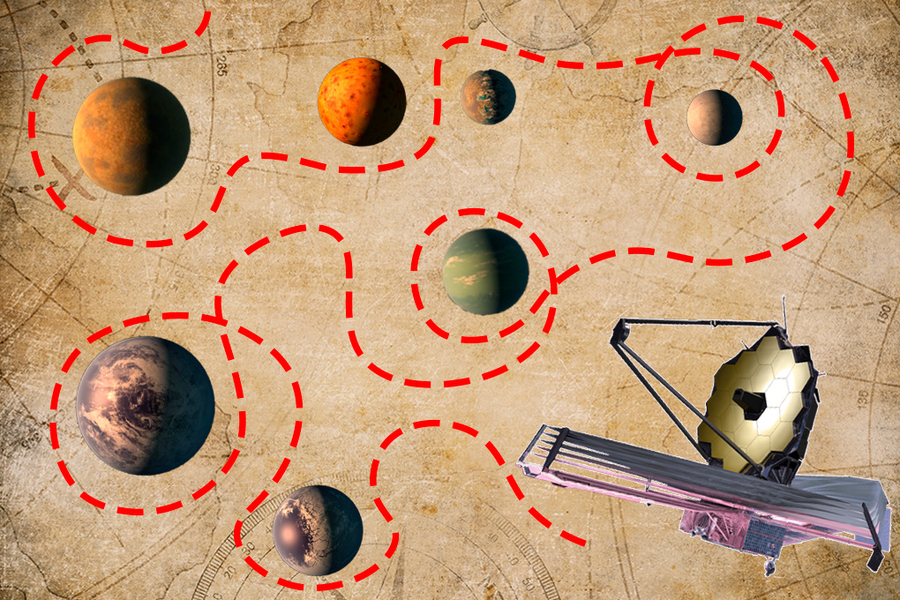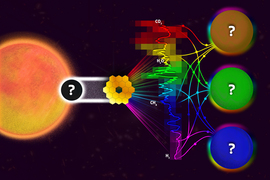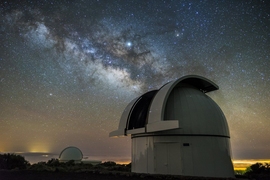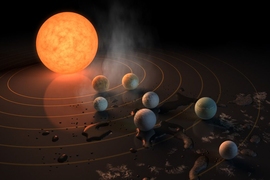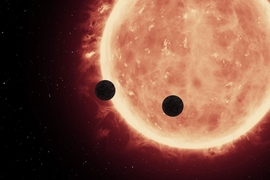The launch of NASA’s James Webb Space Telescope (JWST) in 2021 kicked off an exciting new era for exoplanet research, especially for scientists looking at terrestrial planets orbiting stars other than our sun. But three years into the telescope’s mission, some scientists have run into challenges that have slowed down progress.
In a recent paper published in Nature Astronomy, the TRAPPIST-1 JWST Community Initiative lays out a step-by-step roadmap to overcome the challenges they faced while studying the TRAPPIST-1 system by improving the efficiency of data gathering to benefit the astronomy community at large.
“A whole community of experts came together to tackle these complex cross-disciplinary challenges to design the first multiyear observational strategy to give JWST a fighting chance at identifying habitable worlds over its lifetime,” says Julien de Wit, an associate professor in MIT’s Department of Earth, Atmospheric and Planetary Sciences (EAPS) and one of the lead authors of the paper.
Two-for-one deal
Located 41 light years from Earth, the TRAPPIST-1 system with its seven planets presents a unique opportunity to study a large system with multiple planets of different compositions, similar to our own solar system.
“It's a dream target: You have not one, but maybe three, planets in the habitable zone, so you have a way to actually compare in the same system,” says René Doyon from the Université de Montréal, who co-led the study with de Wit. “There are only a handful of well-characterized temperate rocky planets for which we can hope to detect their atmosphere, and most of them are within the TRAPPIST-1 system.”
Astronomers like de Wit and Doyon study exoplanet atmospheres through a technique called transmission spectroscopy, where they look at the way starlight passes through a planet’s potential atmosphere to see what elements are present. Transmission spectra are collected when the planet passes in front of its host star.
The planets within the TRAPPIST system have short orbital periods. As a result, their transits frequently overlap. Transit observation times are usually allotted in five-hour windows, and when scheduled properly, close to half of these can catch at least two transits. This “two-for-one” saves both time and money while doubling data collection.
Stellar contamination
Stars are not uniform; their surfaces can vary in temperature, creating spots that can be hotter or cooler. Molecules like water vapor can condense in cool spots and interfere with transmission spectra. Stellar information like this can be difficult to disentangle from the planetary signal and give false indications of a planet’s atmospheric composition, creating what’s known as “stellar contamination.” While it has often been ignored, the improved capabilities of the JWST have revealed the challenges stellar contamination introduces when studying planetary atmospheres.
EAPS research scientist Ben Rackham ran into these challenges when they derailed his initial PhD research on small exoplanets using the Magellan Telescopes in Chile. He’s now seeing the same problem he first encountered as a graduate student repeating itself with the new JWST data.
“As we predicted from that earlier work with data from ground-based telescopes, the very first spectral signatures we're getting with JWST don't really make any sense in terms of a planetary interpretation,” he says. “The features are not what we would expect to see, and they change from transit to transit.”
Rackham and David Berardo, a postdoc in EAPS, have been working with de Wit on ways to correct for stellar contamination using two different methods: improving models of stellar spectra and using direct observations to derive corrections.
“By observing a star as it rotates, we can use the sensitivity of JWST to get a clearer picture of what its surface looks like, allowing for a more accurate measuring of the atmosphere of planets that transit it,” says Berardo. This, combined with studying back-to-back transits as proposed in the roadmap, collects useful data on the star that can be used to filter out stellar contamination from both future studies and past ones.
Beyond TRAPPIST-1
The current roadmap was born from the efforts of the TRAPPIST JWST Community Initiative to bring together separate programs focused on individual planets, which prevented them from leveraging the optimal transit observation windows.
“We understood early on that this effort would 'take a village' to avoid the efficiency traps of small observation programs,” says de Wit. “Our hope now is that a large-scale community effort guided by the roadmap can be initiated to yield deliverables at a timely pace.” De Wit hopes that it could result in identifying habitable, or inhabitable, worlds around TRAPPIST-1 within a decade.
Both de Wit and Doyon believe that the TRAPPIST-1 system is the best place for conducting fundamental research on exoplanet atmospheres that will extend to studies in other systems. Doyon thinks that “the TRAPPIST-1 system will be useful not only for TRAPPIST-1 itself, but also to learn how to do very precise correction of stellar activity which will be beneficial to many other transmission spectroscopy programs also affected by stellar activity.”
“We have within reach fundamental and transforming answers with a clear roadmap to them,” says de Wit. “We just need to follow it diligently.”
